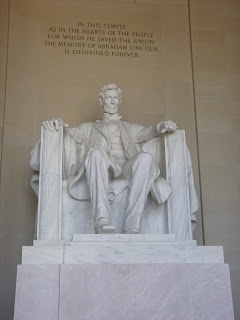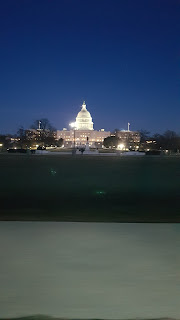We walked to Union Station, which is only a 5-10 min walk (depending on how cold it is!), and then jumped on a Red Line Circulator bus, which goes around museums and monuments along the National Mall. We hopped off at the Thomas Jefferson Memorial. Around the statue of Jefferson are representations of some of the things he enjoyed, such as corn (for horticulture), books (for his extensive collection and a scroll (for his diplomat work and being the third president of the US and author of the Declaration of Independence). He believed in rights of man and a government derived from the people, in freedom of religion and the separation between church and state, and in education for all. He died on 4 July 1826, 50 yrs after the signing of the Declaration of Independence - how ironic is that.
We jumped back on a bus (we had 1 free transfer) and got off again at the Lincoln Memorial. Lincoln was the 16th president and lead the country into and through its greatest trial, the Civil War. After 4 yrs of bloody conflict, he issued the Emancipation Proclamation to free slaves within the states in rebellion and he secured Congressional approval of the 13th Amendment, that abolished slavery in the US. He was assassinated in 1865, and in 1867, there were already plans to build a memorial. But, the memorial was not begun until 1914. The actual statue of Lincoln is 19ft tall and 19ft wide and is made from 28 marble blocks. There are quotes from his Gettysburg Address and his 2nd Inaugural Address inside the memorial, which has 36 columns (the number of states in the Union at the time of his death). His only surviving son was present at the dedication of the memorial in 1922, and there are now no surviving ancestors of Lincoln.
We then saw the Vietnam Veterans Memorial, which was the first national veterans memorial, and honours the men and women who served in the Vietnam War over the course of nearly 20yrs. The black granite has over 58,000 names etched into it, in the order they died each day during the conflict (or went missing). We found 2 Coffin names: Jeffrey A Coffin, a W/O, and Donald A Coffin. There are also two statues, The Three Servicemen and Vietnam Women's Memorial, which make up the memorial.
From there, we headed to the Korean War Veterans Memorial, which created quite an impact with its statues of men trudging along for miles, dressed for rain and carrying their supplies. The US fought alongside a number of other nations in Korea as part of the United Nations, and these countries are listed at the memorial (including New Zealand and The Netherlands).
The World War II Memorial commemorates the over 400,000 men and women who died during the war. There is a wall with 4,048 stars on it (each one represents 100 people). It was here that Pita, Karl, Robin & I received our National Park Service Junior Park Ranger badges for all the work we had completed (& all the facts we had learnt).
We wandered past the Washington Memorial, which honours the 1st President of the US, George Washington. The monument is 555 ft & 5 1/8" tall and towers over the capital. It began in 1848, but stopped when only 156ft in 1858 due to lack of funding. Construction began again in 1878, with stone from a different quarry which resulted in two shades on the monument. The marble capstone weighs 3,300 pounds and was topped with a 9" pyramid of cast aluminum.
Next stop for us was the US Holocaust Memorial Museum, which is not an answer but rather is a question. The question is: What is our responsibility now that we have seen, now that we know? The museum provides spaces for us to learn, remember and act. We learnt by viewing the various exhibits covering the period of the Holocaust from 1933 to 1945, showing the rise to power of the Nazi Party, and how the Nazi ideology led to persecution, world war and mass murder (of Jews, Roma (Gypsies), people with disabilities, Poles, homosexuals, Jehovah's Witnesses, Soviet prisoners of war, and political dissidents); it showed the range of possible responses from individuals, institutions and nations. Artifacts and photos showed how an entire nation was mobilized together against the groups listed above ("racially inferior"). There were displays on the ghetto experience, mass murder and the world of concentration camps. But there were also displays sharing stories of the courageous non-Jews who risked death or imprisonment to save lives, and of the Jews who fought back in ghettos, forests and even in killing centres. As Karl said afterwards, it was sobering being there. Robin said it was horrible what happened.
On our return to the apartment, we saw the Capitol Building with the light shining in the top of the dome, which indicates that the Senate is still in session.















HI to you all, that sounds like a really interesting day, and good history learning! Keep warm!
ReplyDeleteDiane, Kim and David xx